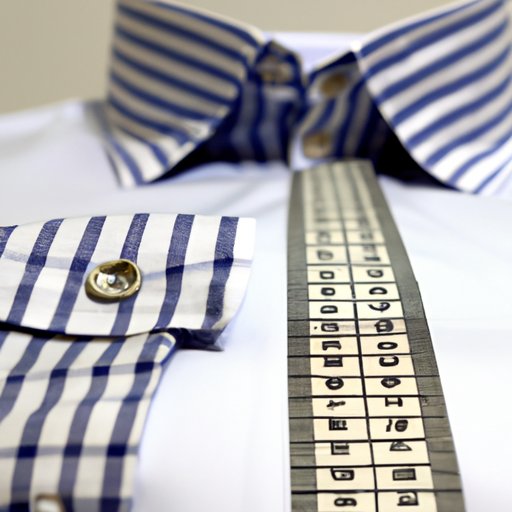Introduction
A dress shirt is an essential item in many people’s wardrobes. It is usually worn with a suit or blazer and is a staple for formal occasions. It is important to have a dress shirt that fits correctly in order to look polished and professional. This article will discuss how to find the right fit for your dress shirt by examining the different elements of a dress shirt’s fit, exploring the role of fabric in determining shirt fit, identifying poorly fitting dress shirts, investigating the impact of alterations on shirt fit, comparing casual and formal dress shirts, and understanding the latest trends in dress shirt fitting.
Analyzing the Different Elements of a Dress Shirt’s Fit
The first step in finding the perfect dress shirt is to understand the different elements of a dress shirt’s fit. The neck size should be snug but not too tight. The shoulder width should be appropriate for your frame, and the sleeves should end at the base of the wrist. The torso fit should be comfortable and not too loose or too tight. Lastly, the hem length should be long enough so that it stays tucked in when you move around.

Exploring the Role of Fabric in Determining Shirt Fit
The type of fabric used for a dress shirt can also have an impact on the fit. Common fabrics used for dress shirts include cotton, linen, and silk. Cotton is the most common fabric and is known for its breathability and durability. Linen is lightweight and has a more relaxed fit. Silk is luxurious and can be dressed up or down depending on the occasion. The type of fabric chosen can have an effect on the overall fit of the shirt.
Examining How to Identify a Poorly Fitting Dress Shirt
When shopping for a dress shirt, it is important to be able to identify a poorly fitting shirt. Signs of an ill-fitting shirt include a tight neck, shoulders that are too wide or too narrow, sleeves that are too long or too short, and a torso that is too boxy or too tight. It is also important to avoid common mistakes when buying dress shirts, such as buying a shirt that is too big in order to accommodate future weight gain or buying a shirt without trying it on first.

Investigating the Impact of Alterations on Shirt Fit
Alterations can also be used to customize the fit of a dress shirt. Common alterations include taking in the sides of the shirt, shortening the sleeves, and adjusting the collar size. Alterations can be beneficial if done correctly, however they can also have limitations. It is important to consult with a tailor or seamstress to ensure that the alterations will not compromise the integrity of the garment.

Comparing Casual and Formal Dress Shirts
In addition to understanding the different elements of a dress shirt’s fit and the role of fabric, it is also important to consider the difference between casual and formal dress shirts. Casual dress shirts typically have more relaxed fits and are made from lighter fabrics. They often feature patterns or brighter colors. Formal dress shirts usually have more structured fits and are made from heavier fabrics. They often feature solid colors and subtle details.
Understanding the Latest Trends in Dress Shirt Fitting
The latest trends in dress shirt fitting include skinny fit, slim fit, and classic fit. Skinny fit is a more fitted style and is best suited for those with a slender frame. Slim fit is a slightly looser style and is best suited for those who want a tailored look. Classic fit is a traditional style and is best suited for those who prefer a more relaxed fit.
Conclusion
Finding the right fit for your dress shirt can be challenging. It is important to understand the different elements of a dress shirt’s fit, explore the role of fabric in determining shirt fit, identify poorly fitting dress shirts, investigate the impact of alterations on shirt fit, compare casual and formal dress shirts, and understand the latest trends in dress shirt fitting. With this information, you can find the perfect dress shirt that looks great and feels comfortable.
(Note: Is this article not meeting your expectations? Do you have knowledge or insights to share? Unlock new opportunities and expand your reach by joining our authors team. Click Registration to join us and share your expertise with our readers.)
